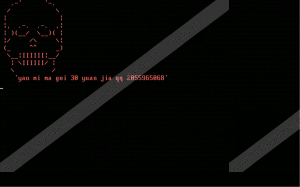MBRlock Ransomware Removal Guide
Do NOT open random spam emails because you are at risk of letting in MBRlock Ransomware and many other malicious ransomware infections. Although most encrypt files, and the victims are usually incapable of recovering them, this is not the case with the malware discussed in this report. The infection is also known by the name “DexLocker Ransomware,” and it appears that it was created to infect Windows operating systems in China. This is the assumption we are making because the ransom note is represented in simplified Chinese and because the ransom is demanded in Yuan. This particular threat does not appear to encrypt files – at least not the version tested in our internal lab – but it can modify the Master Boot Record (MBR) to lock the operating system and introduce you to the ransom note. Even if you think that paying the ransom is not that big of a deal, we can offer you a solution that will help you save your money. Continue reading to learn how to unlock your system for free, as well as how to delete MBRlock Ransomware.
You might let MBRlock Ransomware in not only by opening corrupted spam email attachments. Our researchers warn that several other security backdoors could be employed to infiltrate this malicious threat. The worst part is that you are likely to be tricked into executing it yourself. We do not know where the .exe file lands, but if you decide to remove MBRlock Ransomware, you will need to figure this out. Hopefully, you know exactly where to find it. If you do not eliminate the file immediately, the file automatically modifies the MBR, and the system is then rebooted. Instead of rebooting as per usual, it loads a ransom note that demands 30 Yuan to be sent to the qq address, 2055965068. Besides that, there is no more information, and so you are likely to be completely confused. Unfortunately, regardless of how many times you restart the computer, you will be greeted by the same message, and that is when you might decide that paying the ransom of 30 Yuan is the only thing you can do. Unfortunately, even if you pay the ransom, the malicious ransomware will not remove itself.
We cannot confirm that your operating system will return to normal if you pay the ransom, which is why we do not recommend wasting your money. Your system is most likely to remain locked if you pay the ransom, but that is not the only reason you should NOT pay it. It seems that the victims of this malware can successfully unlock their systems for free by using the “ssssss” password. When the ransom note appears, you are provided with the option to enter a password, most likely, to trick you into thinking that a password would be provided to you if you paid the ransom. Luckily, the “ssssss” password might work, and, hopefully, it will help you restore access to the operating system. Our research team tested the password, and it worked. Of course, we cannot predict if or not the infection would be updated, and if the password does not work, please post a comment below, and our researchers will investigate the situation further. For now, this is the only password that works with MBRlock Ransomware.
What should you do if the known MBRlock Ransomware password does not recover access to the operating system? In this case, you will probably need to repair the Master Boot Record, and that is not the easiest of tasks, and you need to have the Windows installation DVD. If you are looking into this option, think if you are experienced enough to handle this task. Once you are able to access your Windows operating system as per normal, you need to remove MBRlock Ransomware immediately. As mentioned before, we cannot tell you were to look for the executable of this malware. If you cannot find and delete it yourself, it might be high time you installed an anti-malware program. The most important reason to install it, of course, is to have your operating system protected. If you do not install a reliable anti-malware program, you will continue being targeted by cyber criminals and schemers in the future.
How to delete MBRlock Ransomware
- Type ssssss in the area available on the ransom note.
- Tap the Enter key to activate the operating system.
- Once the system boots up, find the {random name}.exe file that represents the infection.
- Right-click and Delete the file (if you cannot find it, try using a legitimate malware scanner).
- Empty Recycle Bin and then immediately perform a full system scan to check for leftovers.
Note that if the password does not work, you will need to repair the MBR using the Windows installation DVD.
MBRlock Ransomware Screenshots:

MBRlock Ransomware technical info for manual removal:
Files Modified/Created on the system:
| # | File Name | File Size (Bytes) | File Hash |
|---|---|---|---|
| 1 | MBRlock.exe | 864256 bytes | MD5: 7e179d064b2d20b4ea5e6d492abf8f2b |
Memory Processes Created:
| # | Process Name | Process Filename | Main module size |
|---|---|---|---|
| 1 | MBRlock.exe | MBRlock.exe | 864256 bytes |

